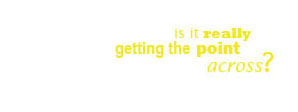


 |
This project was created for IDS 110 at the University of California, Berkeley. As the Internet becomes a larger part of our society, it is important to understand the relationship between the online, virtual world and society. The purpose of this class is to link the two, and comprehend the connections and consequences of the Internet and society. I chose this subject to research because it is very important in today's world. As more people communicate online, it is important for people to know the possible consequences of their actions. This conflict influences a great deal of the world's population, however, it is not very commonly discussed. This website is aimed to increase knowledge and concern about this growing problem in today's society. Hopefully, this awareness will create change in the commonly used programs to help solve these problems. In this class, I learned to use Javascript, Flash, Dreamweaver, and Photoshop. Throughout the semester, I slowly learned the basics of Javascript and common problems a programmer may encounter. Starting with a blank slate, I used the Dreamweaver program to design this website. I came across many conflicts I had to work through or around. Creating a simple and easy-to-use website was one of the most important aspects of this project. I worked hard to create a user-friendly site, which also provides valuable information for this increasingly relavent and crucial subject. Also, I tried to make a website that was professional, but still aesthetically pleasing. Although I did spend time on the design of the website, I also wanted to assure that the user's attention would not be distracted from the content. By using Flash, I was able to create an interactive site for the users, which would help keep focus on the topic of my research.
My research includes sources from books, articles, and websites. Many researchers and authors have new attention for this subject, and many pieces of information have been produced to deal with this topic. The opinions and ideas presented in this project are my interpretations of the information I found in my research from the following sources:
Works Cited "A Nation Online: How Americans are Expanding Their Use of the Internet." 22 February 2002. Economics and Statistics Administration. 12 November 2006 <https://www.esa.doc.gov/reports/anationonline2.pdf> Arrington, Michael. "College Students use Facebook." TechCrunch. 7 September 2005. 12 November 2006 <http://www.techcrunch.com/2005/09/07/>. Atton, Chris. An Alternative Internet. Endinburgh: Endinburgh University Press, 2004. Christine Paul. "Telepresence, telematics, and telerobotics." Digital Art, London: Thames & Hudson 2003. "Communication Creates Conflict." 1 January 2005. CyberCafe. 3 December 2006 <http://www.dartmouth.edu/~arthist/content/websites/website2/website2.html>. "Community Relations." 14 October 2006. IBM. 24 October 2006 <http://www-8.ibm.com/ibm/au/community/>. "How is Online Communication Different?" 24 November 2003. About: Mental Health. 11 October 2006 <http://mentalhealth.about.com/cs/computerstuff/a/onlinecom.htm>. "How Many People Use the Internet?" 3 April 2006. New Media Concepts. 11 October 2006 <http://www.nmc-usa.com/how%20many.html>. "MySpace." Wikipedia, The Free Encyclopedia. 4 December 2006. Wikimedia Foundation, Inc. 6 Decmeber 2006 <http://en.wikipedia.org/wiki/Myspace>. Online Communication. 15 January 2001. RMIT University. 12 November 2006 <http://www.lts.rmit.edu.au/renewal/onlcomm/>. "Telepresence." 14 November 2004. SpaceCast 2020. 1 December 2004 <http://www.fas.org/spp/military/docops/usaf/2020/index.html>. Virtual University Design and Technology. 11 October 2001. Michigan State University. 18 July 2006 <http://vudat.msu.edu/communicate_online/>. Wilson, Michele A. Technically Together: rethinking community within techno-society. New York: Peter Lang, 2006.
|